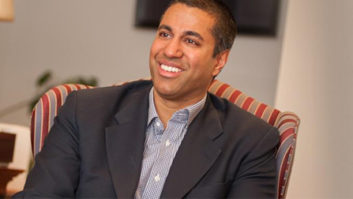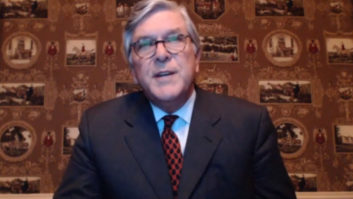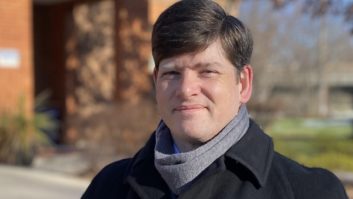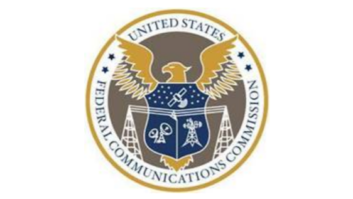
Here’s the text of FCC Commissioner Ajit Pai’s remarks at the NAB Show AM Band Revitalization Panel on Monday.
Good afternoon and welcome to today’s discussion on AM radio revitalization. I’d like to thank NAB for inviting me to moderate this afternoon’s event and our distinguished panelists for their willingness to participate. This panel has been circled on my calendar for a couple of reasons. First, I’ve been looking forward to attending an event where my role would be to ask the questions rather than answer them; it’s a nice change of pace not to be on the hot seat. Second, and more importantly, I have a personal interest in the future of AM radio.
Growing up in Parsons, Kansas, I regularly tuned in to our local AM station, KLKC 1540. I still remember listening in my room to the KLKC broadcast of the 1987 5A state basketball championship, which Parsons High School won (my mom wouldn’t let her freshman son travel a few hours away to watch the game in person). KLKC is still around today. In fact, at this very moment, it is broadcasting this afternoon’s baseball game between the Kansas City Royals and the Minnesota Twins. Back in Washington, DC, one of my favorite AM radio stations is ESPN 980, where less than two weeks ago, I had the pleasure of sitting in on a taping of The Tony Kornheiser Show. As a longtime fan – or “little,” as they’re known – I can assure you that this was one of the highlights of my tenure at the Commission to date.
But my experience with AM radio isn’t unique. When you speak with others about the AM band, you evoke a wide range of memories, from the child lying in bed on a warm summer night listening to a baseball game to the salesman driving in his car listening to Paul Harvey’s commentaries. Indeed, this year’s Super Bowl commercial featuring Paul Harvey struck such a nerve, I’d bet, due in part to the pull that broadcast radio still exerts on the American people.
Today, however, AM broadcasters are facing difficult challenges. To throw out just a couple of statistics, in 1978, half of all radio listening was on the AM dial; in 2010, that number was only 17%. And since 1990, the number of AM stations has decreased while the number of FM stations has almost doubled. Why is this? Based on my own experience, AM signal quality seems to be a major factor. Due to widespread interference, it seems to get tougher every day to receive a quality AM signal. But I look forward to hearing from the real experts, our panelists, on what is responsible for these trends and what we can do to change them.
Now, I realize that there are those who don’t have much interest in reversing these trends. Last week, for instance, a TV columnist at Variety criticized today’s panel and called AM radio a “cesspool” to boot. Well, to paraphrase Lynyrd Skynyrd, “a radio man don’t need him around, anyhow.” I still believe, as I proposed at the Radio Show last September, that the FCC should launch an AM Radio Revitalization Initiative. It’s been over two decades since the Commission last comprehensively reviewed its AM radio rules, and I think that it’s time for us to do so again. We should explore proposals for improving the AM band and making sure that it remains viable. I’ve been amazed by the response to this initiative, and I’m incredibly grateful for the outpouring of support. You’ve shared many creative ideas with me over the course of the last few months, and I’m eager to discuss some of them with our panelists.
To that end, I’d like to highlight up front a few topics that have generated a fair amount of chatter.
First, should the FCC make it easier for AM broadcasters to obtain and use FM translators? And if so, how? Some say that FM translators are critical to bringing new life to AM broadcasters; others say that translators are just a Band-Aid that does nothing to solve AM’s long-term problems.
Second, should AM stations be allowed to increase their current power? In 2010, a petition was filed asking the FCC to allow all AM stations to increase their power tenfold. Advocates of an across-the-board power increase say it would help AM stations overcome interference caused by the numerous electronic devices that simply didn’t exist when AM power levels were first set. Is this proposal realistic? Or are there other steps that we should take to reduce interference on the AM band?
Third, should we aim to transition the AM band to digital? Digital AM advocates say that a transition would result in better audio quality and improved reception. If we move to digital AM, how should that transition be structured? How long will it take? Will the FCC need to impose an analog sunset date, just as Congress did for the DTV transition? What impact would a digital transition have on smaller AM broadcasters?
Finally, should we move to AM synchronous transmission systems? As you know, synchronous transmission uses multiple small broadcast nodes, instead of a traditional AM tower, to broadcast. These are lower in power than today’s AM towers, but by using a field of nodes, advocates say that a broadcaster can keep power levels high near listeners while achieving a lower interference and skywave profile. This proposal is a interesting one from a technical perspective, so I’m curious to hear about its real-world feasibility.
These are just a few of the many ideas that AM operators have offered for revitalizing the AM band. I’m confident that we’ll hear even more today from our distinguished guests, who bring with them a wealth of experience from different parts of the radio business and are the real stars of our show. Let’s talk radio.







